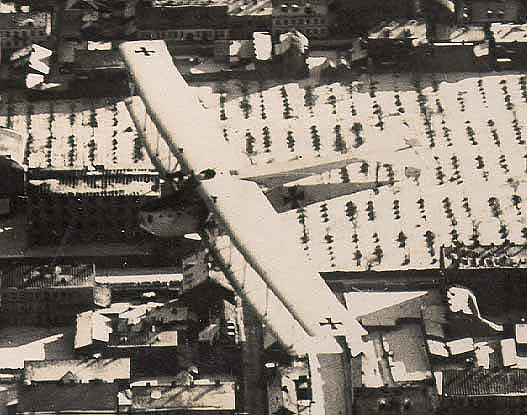Siemens-Schuckert R.VI Bomber – Bialystok March 1917
Siemens-Schuckert Werke built the only other series of operational R-planes apart from Staaken. There were seven of them: the first, the R I, flew at the same time as the VGO.I in 1915 and was just as brave a pioneering effort. They were used against the Russians on the Eastern Front. Unlike the Staaken machines they featured engines buried in the fuselage, in the nose, driving propellers via gears and extension shafts. So it was more vulnerable to mechanical problems, but it was easier to service the engines in flight.
I’ve featured the R VI here because it’s the subject of an eye opening story recounted in Grosz and Haddow’s book which illuminates the remarkable sang froid of the aviators of the time, and also what made the R-planes such special machines. This was a record-breaking 6 hour factory flight in April 1916. During take-off a radiator hose broke, and that was stopped with a rag and wire compress. Later, an exhaust pipe burst, releasing choking fumes; a bit more work was needed to reduce the split to a minimum. Next, they found that the left engine was leaking oil. They plugged the leak and drew oil from the other engines, but near the end of the flight it seized and stopped entirely. They actually managed to take out the spark plugs, re-oil the cylinders and with careful use of the clutch, restart the engine. Unbelievable isn’t it! And it wasn’t at all unusual in the R-planes for an engine to be stopped in flight and repaired.
Despite this remarkable flight, the R.VI did not meet the specifications issued by the Idflieg in its contract with Siemens-Schuckert. Therefore, the Idflieg opted to relax the original specifications somewhat and complete the purchase of the aircraft.
The R VI was in service until November 1917.
Specifications
General characteristics
Crew: 4
Length: 17.7 m (58 ft 1 in)
Wingspan: 33.36 m (109 ft 6 in)
Height: 4.6 m (15 ft 8 in)
Wing area: 177 m2 (1,910 ft2)
Empty weight: 5,250 kg (11,550 lb)
Gross weight: 6,660 kg (14,650 lb)
Powerplant: 3 × Benz Bz.IV, 150 kW (200 hp) each
Performance
Maximum speed: 132 km/h (83 mph)
Range: 720 km (450 miles)
Service ceiling: 2,950 m (19,400 ft)
Armament
3 × 7.9-mm machine guns
500 kg of bombs
Offermann, W. G. Noack, and A. R. Weyl, “Riesenflugzeuge, in: Handbuch der Flugzeugkunde” (Richard Carl Schmidt & Co., 1927).
Haddow, G.W. & Grosz, Peter M. “The German Giants, The Story of the R-planes 1914–1919”. London. Putnam. (1962, 3rd ed. 1988).ISBN 0-85177-812-7
Gray, Peter & Thetford, Owen. “German Aircraft of the First World War”. London, Putnam. (2nd Ed.) 1970. ISBN 0-370-00103-6
Wagner, Ray and Nowarra, Heinz, “German Combat Planes”, Doubleday, 1971.
